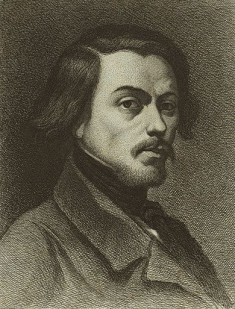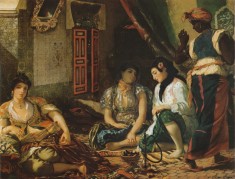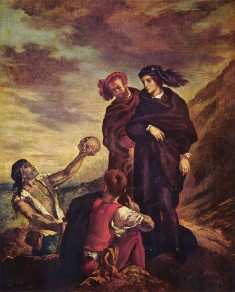French painter, author, muralist, lithographer, and drafter Eugène Delacroix (1798-1863), became famous for leading the French Romantic Movement in painting. The Romantic Movement in art began to grow after the French Revolution as a response to the violence and the rigidity of the Neoclassical Movement. Romantic painters believed in the importance of nature, passion, and high emotion. They believed in the overall goodness of the human race and that all people should have justice.
A Brief History of Romanticism
Romanticism actually began in Germany in the early 1800s, gradually evolving throughout the century and spreading to various European countries.
To express their feelings and beliefs, Romantic painters, such as Eugène Delacroix, painted many landscapes and individual portraits using gentle and realistic expressions. These techniques played against light and color to serve as a foil for the unemotional and rational Neoclassical style.
Romantic painters typically painted in various styles depending on the country in which they lived. For Eugène Delacroix, he used strong brush strokes in his paintings to evoke a general movement of emotion and passion, which many art critics of the time resisted. Eugène Delacroix’s personality perhaps explained why he was drawn to such a movement that placed the emotions of an individual over the intellect.
The Early Life of Delacroix
The man who was to lead the French Romantic School was born April 26, 1798, near Paris. His father, Charles Delacroix, who had supported the most violent faction during the French Revolution, died when Eugene was only seven years old. Afterwards, his mother moved back to Paris and placed him in school.
 Eugène Delacroix’s early years were rife with horrible accidents which followed him throughout his life. When Eugene was an infant, a nurse fell asleep while reading a book by candlelight. This caused a fire which almost consumed him and left him scarred. Another nanny dropped her young French charge into the ocean while she was climbing to a secret rendezvous with her lover.
Eugène Delacroix’s early years were rife with horrible accidents which followed him throughout his life. When Eugene was an infant, a nurse fell asleep while reading a book by candlelight. This caused a fire which almost consumed him and left him scarred. Another nanny dropped her young French charge into the ocean while she was climbing to a secret rendezvous with her lover.
Eugène Delacroix also suffered near-fatal poisoning and choking. In one high passion incident, he almost hung himself. He was not trying to commit suicide, however. Instead, he was trying to recreate a painting he had seen of a hanged man.
When he decided to become a painter, Eugène Delacroix began studying under the tutelage of Baron Pierre-Narcisse Guerin. There, he was treated with condescension by his teacher. He also experienced outright dislike and a sense of lifelong competition and animosity with fellow pupil, Ary Scheffer.
Eventually, Eugène Delacroix picked up loyal patrons, the most notable being Duchesse de Berry Caroline. But his early struggles left him scarred both physically and emotionally.
The Works of Eugene Delacroix
 Despite the humiliation of his early years, Eugène Delacroix was to lead the French Romantic Movement. His first famous painting was Dante and Virgil, which he created in his own studio. His teacher, Baron Guerin, became enraged and berated both it and Eugène Delacroix himself once he saw the work. Eugène persisted, and the work was exhibited at the Salon in 1822.
Despite the humiliation of his early years, Eugène Delacroix was to lead the French Romantic Movement. His first famous painting was Dante and Virgil, which he created in his own studio. His teacher, Baron Guerin, became enraged and berated both it and Eugène Delacroix himself once he saw the work. Eugène persisted, and the work was exhibited at the Salon in 1822.
Delacroix’s large depiction of the tragic Massacre of Chios got recognized as important art by the French government. It was placed in the Luxembourg in 1824. Delacroix stayed with Greek tragedy for his next few works to depict his strong feelings about the Greek war for independence occurring at the same time. An exhibit of his works in this vein debuted in 1826 and was visited by many Greek patriots.
Final Works and Later Years
 Eugène Delacroix received the honor of being asked to decorate several notable facilities, starting in 1845 with the Library of the Luxembourg, the Chamber of Deputies in 1847, a portion of the ceiling in the Louvre in 1849 and the Salon de Paix in 1853.
Eugène Delacroix received the honor of being asked to decorate several notable facilities, starting in 1845 with the Library of the Luxembourg, the Chamber of Deputies in 1847, a portion of the ceiling in the Louvre in 1849 and the Salon de Paix in 1853.
He died on August 13, 1863. In 1864, a posthumous exhibit containing nearly 200 works, from paintings to drafting projects to lithographs, showed his versatility as an artist, his strong work ethic, and his immense grasp of the craft of drawing and composition as a whole.
Since this exhibit, he has come to be recognized as the leader of the French Romantic Movement in art.
